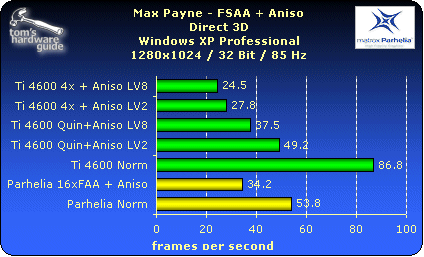Attack Out Of The Blind Spot: Matrox Parhelia-512
Anisotropic + Anti-Aliasing Performance, Continued
It's a similar picture with Max Payne. At higher resolutions, however, the GeForce 4 with 4x FSAA falls further behind.
It's difficult to draw a conclusion from the quality comparison, since this depends heavily on one's personal preferences. You could suggest that it's unfair to evaluate the GeForce 4 at the highest level of anisotropic quality, because the Parhelia filters much less. Still, we decided that maximum image quality offered by both cards was a central point. By contrast, if you analyze the cards at the same level of filtering, then the GF4 Ti is significantly better.
With regard to FSAA quality, Parhelia is clearly ahead of the GeForce 4 - if Fragment AA functions, that is. If it doesn't, then it looks pretty bad for Parhelia, because the SuperSampling is rendered useless by the lame performance.
The GeForce 4 presents a good compromise between quality and performance with Quincunx and anisotropic filtering. However, if you're looking at maximum quality, then we consider Parhelia to be the winner, despite the poorer anisotropic filtering, because the edges look much smoother and you get a better overall image than with the GeForce 4, thanks to Fragment AA. And yet, the advantage here is only slight.
So that you can judge for yourselves, we've provided you with the screenshots for both cards, which you can download in the original size and uncompressed. When viewing them, you should set the desktop resolution to 1024x768-32.
Get Tom's Hardware's best news and in-depth reviews, straight to your inbox.
Current page: Anisotropic + Anti-Aliasing Performance, Continued
Prev Page Anisotropic + Anti-Aliasing Performance Next Page 3D Mark 2001 SE Details

